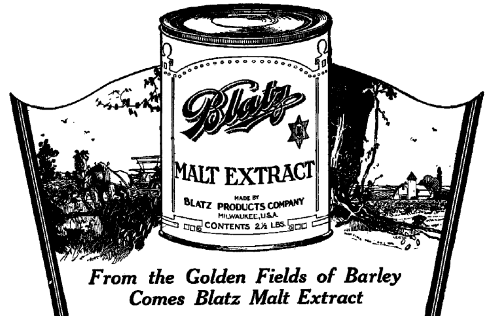Thursday, July 7, 2005
Page 15
REMINISCING (Column)
Breweries Survive Prohibition by Selling Malt Extract
By ROGER M. GRACE
What does a beer-maker make when the beer-maker can’t make beer?
During Prohibition (1920-33), some breweries—including those that made Budweiser, Schlitz, Miller, Pabst and Blatz beers—turned to production of malt extract. There was suddenly a consumer demand for that product, marketed as being useful as an ingredient in breads and desserts. That was, of course, not the use to which malt extract— typically flavored with hops—was most commonly put.

The Lima (Ohio) News on March 31, 1929 noted:
“Local distributors of malt syrup reported that an average of approximately 8,000 cans of malt extract are sold in this city every week. The contents of each can will make at least 50 pint bottles of beer, thus the weekly consumption of malt in Lima has the beverage equivalent of 400,000 pints of home brew.”
The article said that one malt extract label advised: “For bread making use one half as many tablespoonsful of malt extract as formerly used of sugar. [¶] This will make the bread light and perfectly browned.”
The newspaper observed that “no mention is made as to what benefit the hops are to bread.”
The newspaper reckoned that “enough malt extract is sold each week in Lima to provide the necessary sweetening for 800,000 loaves of bread, or more than 16 loaves for every man, woman, and child.”
Writing for the Seventh U.S. Circuit Court of Appeals in 1922, Judge Samuel Alschuler spelled out the predominant use to which malt extract was being applied:
“Prior to prohibition, there was little or none of the present notoriously prevailing practice of making ‘home brew.’ If persons wanted beer, they would go out and buy it; and if nowadays they desire the product called ‘near beer,’ they go into the market and purchase such make of it as they wish. It is not supposable that persons would trouble themselves to procure the ingredients for near beer and make it at home. It may well be assumed that, in so far as this product is employed as an ingredient for making any beverage, it is the real, old-fashioned, alcoholic beer....”
“There were actually raids by federal and state authorities on caches of malt extract. The courts tended to frown on attempts to treat a legal product which could be used innocently as something necessarily part and parcel of illegal booze-making.
The Associated Press, in a dispatch datelined Boston, reported on Aug. 22, 1928:
“Federal Judge James M. Morton ruled today that malt extract, from which beer might be manufactured is ‘by no means an outlaw product’ when he dismissed a petition of the government seeking forfeiture of the stock of the New England Malt Products Company, which was seized by prohibition agents.”
Morton was quoted as saying in his written opinion that malt extract was “one of many common food substances that can be used in making alcoholic liquor.”
A United Press dispatch on July 24, 1928 told of a case decided under a state prohibition statute:
“The sale of malt extracts was declared legal today by the supreme court of Michigan, which reversed the conviction of Carl Christenson, Montcalm County, on charges of violating the prohibition laws by selling the extract.”
The opinion, by Justice George M. Clark, said:
“Defendant, a grocer, for having sold a quantity of pasteurized malt syrup, made from barley malt and known as malt extract, was charged with, convicted of, and sentenced for violation of the Prohibitory Law, and he brings error….
“Defendant urges four reasons for reversal. We consider one, that the sale is not an offense under the statute, and in this we think he is right.
“Malt syrup is a food. It is not intoxicating. To make an intoxicating beverage, yeast and water (and commonly sugar) must be added; more than water must be added to the syrup. If the prosecution is right here then it is unlawful to sell any substance which may be used in making intoxicating liquor, such as sugar, cornmeal, raisins, grains, etc. The Legislature neither so intended nor provided.”
Next week: more on malt extract in the Prohibition era.
Copyright 2005, Metropolitan News Company